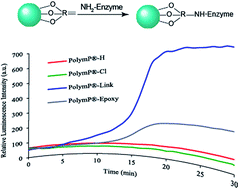Evaluation of different functional groups for covalent immobilization of enzymes in the development of biosensors with oxygen optical transduction†
Abstract
Four different types of polymeric particles with different functional groups on their surface have been evaluated to develop biosensors using glucose oxidase as a model enzyme. Direct covalent immobilization was achieved on particles functionalized with chloride, epoxy and vinyl groups via the reactive functional groups on the surface, whereas particles functionalized with carboxylic groups, used as reference materials, were pre-activated with carbodiimide. Immobilization was successfully performed under very mild conditions (20 °C, pH 8.0). In order to determine the advantages and disadvantages of each functional group, both the amounts of immobilized enzymes and their relative activities were fully investigated. In order to demonstrate their applicability on the design on biosensing with oxygen optical transduction, the functionalized particles were co-immobilized in gold chips with oxygen sensing particles (PSMA–PtTFPP) using electrophoretic deposition and characterised for glucose determination in solution.


 Please wait while we load your content...
Please wait while we load your content...